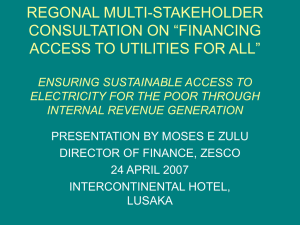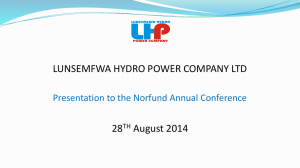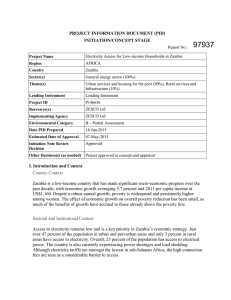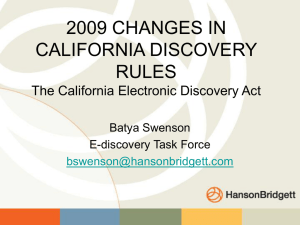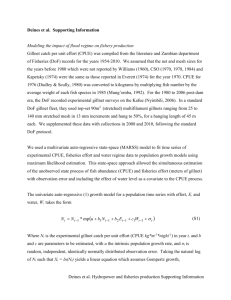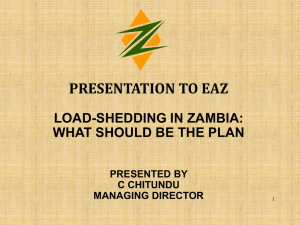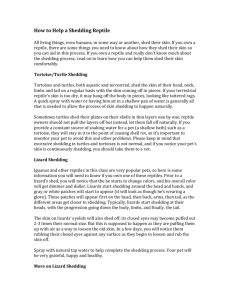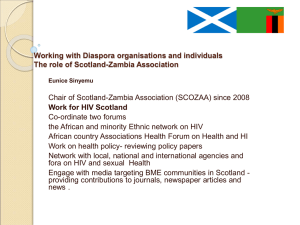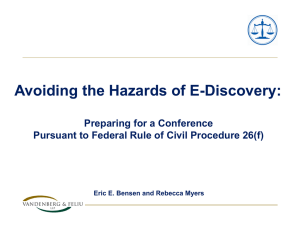Load Shedding in Zambia: What Should be the Plan
advertisement
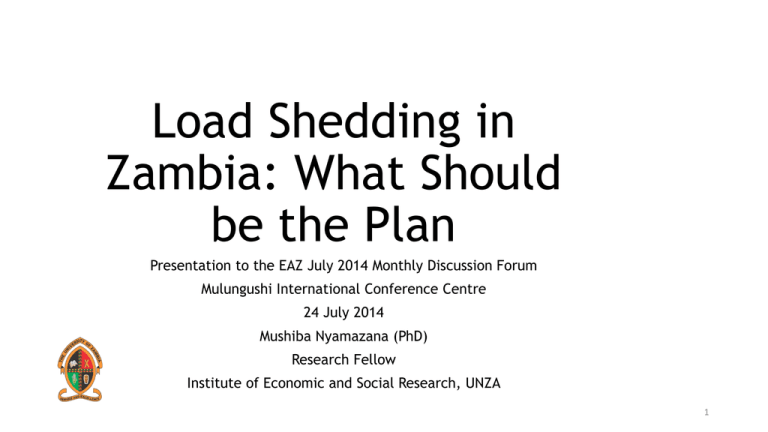
Load Shedding in Zambia: What Should be the Plan Presentation to the EAZ July 2014 Monthly Discussion Forum Mulungushi International Conference Centre 24 July 2014 Mushiba Nyamazana (PhD) Research Fellow Institute of Economic and Social Research, UNZA 1 Outline • Introduction • Demand Projections • Meeting Demand: Investment Implications • Public vs. Private Investments • SAPP Tariff Comparisons • The Solar Power Option • Conclusion 2 Introduction • 1990s SAPP projects SADC power deficit if capacity not increased. • SADC Governments take no action – “business as usual” approach. • From 2005/6 massive load shedding • Lots of talk of more investment but load shedding continues 3 Demand/Power Balance Projections 2014 2015 2020 2025 2030 Total Energy Demand (GWh) 13388 13734 15666 15954 17176 Maximum Demand (MW) 2065 2119 2417 2450 2650 Total Net Energy Generation (GWh) 16100 16100 26288 32875 40085 Installed Generation Capacity (MW) 3045 3045 4992 6035 7240 Energy Balance (GWh) 553 302 8688 22748 21378 Capacity Balance (MW) 647 608 2277 4566 4354 4 Demand/Power Balance Projections II • 2014 comparison of actual vs. projected capacity = adverse gap of 76% (i.e., 2,309.5 actual vs. 3,045 MW projected). • ZESCO/Ministry of Energy not announced remedial measures to catch up through accelerating generating/transmission/ distribution projects implementation. • Knock-on effect on rest of forecast period likely. 5 Proposed Investments in Zambian Power System To Sumbuwanga 8o MPULUNGU MBALA LUNZUA MBEYA KALUNGWISHI MPOROKOSO KASHIKISHI KALUNGWISHI RIVER CONGO (DR) NAKONDE CHISHIMBA FALLS KASAMA MAMBILIMA MUSONDA FALLS LUWINGU ISOKA MANSA ANGOLA CHINSALI MICHELO WEST LUNGA RIVER AT MWINILUNGA (3.5MW) SAMFYA MOMBUTUTA SOLWEZI LUANO KANSUSWA LUSIWASI KABOMPO RIVER AT KABOMPO-MANYINGA BRIDGE (0.10MW) CHIKATA FALLS (10MW) LUNDAZI MPIKA KITWE CHAVUMA FALLS (20MW) SERENJE PENSULO MAPOSA LUFUBU RIVER AT KASEMPA BRIDGE (0.23MW) MFUE MKUSHI MPONGWE ZAMBEZI KAPIRI CHIPATA MSORO LUNSEMFWA KABWE AZELE KALABO LUKULU MULUNGUSHI MUMBWA PETAUKE LUSAKA WEST KAOMA 33.5o East MONGU LEOPARDS HILL KAFUE TOWN KAFUE LOWER KAFUE WEST ITEZHI - TEZHI SENANGA CHIRUNDU MOZAMBIQUE LUANGWA km KEY KAFUE GORGE MAZABUKA KEY KARIBA NORTH 330 kV 1941 km 348 330 kV 77 717 132 kV 88 kV 66 kV 2791 66 kV 220 kV (120MW) MUZUMA LAKE KARIBA KARIBA SOUTH SESHEKE 22o East 132 kV 220 kV 88 kV POWER STATIONS VICTORIA FALLS NAMIBIA PROPOSED LINES PROPOSED POWER STATIONS SUBSTATIONS KATIMA MULILO 18o BOTSWANA PROPOSED SUBSTATIONS ZIMBABWE DIESEL STATIONS DIESEL STATIONS 6 Public Vs. Private Investments Private/IPP PPP/Shared River Course • Maamba (Coal) 300 MW 2013 • Kabompo (34 MW) Kabwelume + Kundabwika (210 combined MW) 2014 • Lusenfwa/Muchinga 120 MW 2016 • EMCO (Coal) 300 MW 2016 • Muchinondo/Luchenene 70 MW 2017 • Itezhi-tezhi 120 MW 2014 • Kafue Gorge Lower 600 MW 2017 • Mumbotutu + Mambilima I and II 326 MW 2018-2019 • Devils Gorge 500 MW 2023 • Mpata Gorge 543 MW 2024 7 Public Vs. Private Investments II • Both IPP and PPP projects implementation depends on Government • Single buyer model not efficient to resolve load shedding/universal electrification: • Each IPP or PPP wants PPA with ZESCO (including ZESCO SPVs) • Each wants ZESCO to provide security and pay upfront • Each wants cost recovery tariff rate but ZESCO average tariffs subeconomic • Unbundling ESI may unlock private sector investments • Restricting legacy hydro power + Open Access regime = increase private sector participation via market creation? 8 Public Vs. Private Investments III • ESI Governance/institutional capacity weaknesses a binding constraint to private investment • Zambia’s evolutionary approach to ESI market reforms not delivering quickly: • The steep rise in non-mining tariffs since 2008 not reflected in significant outcome improvements. • ZESCO KPIs regime not entirely providing incentive for efficiency. • Would adopting Finnish Mankala principle to Zambia ESI help? • Does tariff review that take 2 years to complete help ESI? 9 SAPP Average Electricity Tariff, US$c/kWh 2012/13 11.5 12 9.8 10 8.7 8 8.6 8.2 7.5 7 6.8 6 5.9 5.7 6 4.8 4 2 0 BPC EDM ENE ESCOM ESKOM LEC NamPower SEC SNEL TANESCO ZESA ZESCO 10 Solar Power Option • Hybrid with hydrocarbons • Universal/rural electrification – off grid • Water conservation: solar generation daytime; hydro at night • Voltage/frequency regulation at end of radio lines • Serve newly created districts that cannot be served by national grid 11 Conclusion • Take another look: is plan for resolving load shedding on course? • Work on regulator/utility governance systems. • Market restructuring/unbundling an imperative • Limit legacy hydro in bulk supply contracts • Inject adequate capital in ESI • “Business as usual” will not help Zambia achieve the 2030 Vision. 12 THE END THANK YOU FOR YOUR KIND ATTENTION 13
